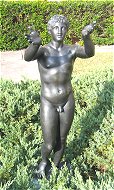Praying BoyMuseum Label: Chiurazzi description: |
Subject info:
Praying Boy - bronze (original Greek Hellenistic ) now in Staatliche Museum, Berlin.
Praying Boy may have been by one of Lysippus's followers. Lysippus was the Court sculptor
of Alexander the Great. This statue was called "Adorans" or the Adorer by Pliny.
Sculptor:
Boidas. 3rd century BC. Sculptor, son of Lysippos. We know nothing about
Boidas, except his work of a bronze statue showing a praying boy (Berlin).
Lysippos was a Greek sculptor of the 4th century BC. Lysippos, Skopas and Praxiteles
are considered the three great sculptors of the Classical Greek era, bringing transition
into the Hellenistic era.
He was the successor of the famous sculptor Polykleitos. Among the works attributed to him
are the so-called Horses of Saint Mark; Eros Stringing the Bow (various copies exist; the
best is in the British Museum); Agias (known from a marble copy found and preserved in
Delphi); Weary Hercules (also known as the Farnese Herakles which was originally placed in
the Baths of Caracalla, though the surviving marble copy is in the Naples Archeological
Museum) and Apoxyomenos or The Scraper (known from a Roman marble copy in the Vatican
Museums).
He was born at Sikyon around 390 BC. A worker in bronze in his youth, he taught himself
the art of sculpture, later becoming head of the school of Argos and Sikyon. He produced,
according to Pliny the Elder, more than 1,500 works, all of them in bronze.
His pupil, Chares of Lindos, constructed the Colossus of Rhodes, one of the seven ancient
wonders of the world. Since this statue does not exist today, debate continues as to
wheather the statue was cast bronze or hammered of sheet bronze.
During his life Lysippos was the personal sculptor of Alexander the Great. A recently
discovered epigram of Posidippus, in the anthology represented in the Milan Papyrus, was
inspired by a bronze portrait of Alexander:
Lysippus, Sikyonian sculptor, daring hand, learned artisan,
your bronze statue has the look of fire in its eyes,
that one you made in the form of Alexander. The Persians deserve
no blame. We forgive cattle for fleeing a lion.
Lysippus can be credited with the stock representation of an inspired, godlike Alexander with tousled hair, lips parted, looking upward; one fine example, an early Imperial Roman copy found at Tivoli, is conserved at the Louvre Museum
